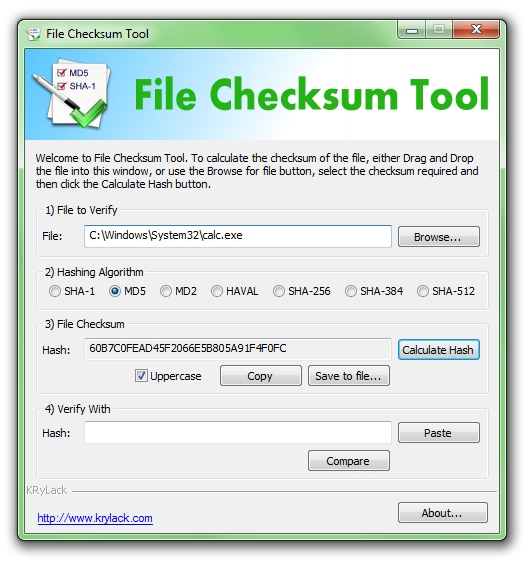Downloading and installing the checksum calculator. Download the Checksum Calculator. Run the executable, checksumcalculatorsetup.exe. Follow the prompts to install the program. Using the calculator. Open the Checksum Calculator if not already opened after the install. Click the Browse next to the file box and browse to the file you want to check. In our example, we are checking the checksum. Click on the Browse button, navigate to the file that you want to check and select it. Just as you select the file, the tool will show you its MD5 checksum. Copy and paste the original MD5 value provided by the developer or the download page. Click on Verify button. MD5 is a utility that lets you create and compare MD5 checksums. It can compare files as well as a file with a checksum-string. Or you can simply let the application calculate a checksum. In this tutorial we will learn to find checksum of a downloaded file in Mac using the terminal. Download the file and get the checksum from the website. Next, depending on the checksum type apply the following checksums. In order to find the MD5 checksum value of a file using the following command in the terminal. $ md5 /path/to/file.
Some Mac users received a nasty surprise last week when it was discovered that a recent version of the open source Transmission BitTorrent client infected their computer with malware — a situation that may have been avoided with proper precautions.
Most savvy computer users know that it's important to be vigilant about where they download software from, but few stop to verify that the file they received is the file they were supposed to receive. This can be a critical final step in preventing malware infections of the sort we saw with Transmission.
Developers often post checksums or hashes alongside the download links for their projects to facilitate this kind of verification. Broadly, a checksum is the result of a mathematical calculation run on a particular file — if the file hasn't been altered, the checksum you calculate will match the checksum provided by the developer.
It's still not clear exactly how the infected download made it onto Transmission's website, but those who received it early in the process have reported that the bad file's checksum didn't match the checksum provided by the Transmission team. If they had verified the checksum before installing, they would've known something was amiss.
It's worth mentioning that this is not an infallible process: if a website is compromised, the attacker could've easily changed the checksum as well. Still, it's a useful — and very quick — precaution to take.
Important note: For most people, files will be automatically placed in their downloads folder. To access this folder in Terminal, use ~/Downloads.
SHA-1 is the checksum format used by Apple, among many others. To find the SHA1 checksum of a file, open a Terminal window and enter the following:
How To Do A Checksum
If your file is called Paint.dmg and it's in the Downloads folder, it would look like this:
The result should look like this:

SHA1(/Users/username/Downloads/Paint.dmg) =07272d863ab77113e38e6ce3878c2162feb4893e

The series of letters and numbers in the result is the checksum: just compare it to the checksum provided by the developer.
Check Checksum Mac
Another popular checksum is SHA256, the kind used by Transmission's team. To verify it on a Mac, use:
How To Check Checksum Windows
Verifying an MD5 checksum
MD5 is no longer recommended as a checksum hash for security reasons, but some legacy programs may still use it. To verify:
How To Check Checksums Iso
AppleInsider has affiliate partnerships and may earn commission on products purchased through affiliate links. These partnerships do not influence our editorial content.